SAR helicopters
Search and rescue duties require high-tech, mission ready aircraft, and passionate crews.
By Jay Chandler
Contributing Writer
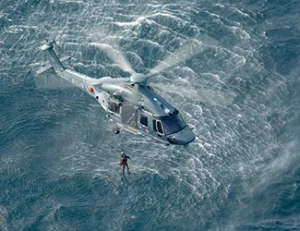
One of the most valiant missions a pilot can fly is the Search and Rescue (SAR) task. Searching for downed pilots or lost hikers can be wrought with fatigue and emotion, but the reward of a successful mission is beyond words.
World War II provided the first opportunity for the helicopter to demonstrate its unique capabilities, when a Sikorsky R-4 helicopter was used to locate and extract 3 downed airmen from the steamy jungles of Burma in April 1944. The first air sea rescue was performed in an R-5 for the US Navy when they plucked a drenched pilot from the ocean in 1946. Since then, helicopters in SAR roles have made monumental improvements and saved countless lives.
The “rescue” of SAR can’t take place until the “search” part is successful. Modern technology like emergency locator transmitters (ELTs), personal locators, and GPS trackers have shortened search times greatly, but these are not always available. To assist, SAR organizations like the Civil Air Patrol (CAP) also use radar analysis technology and cell phone forensics to locate a large number of downed aircraft. In 2022, CAP was credited with 391 finds and 151 lives saved.
For offshore SAR operations in the US, the US Coast Guard operates a fleet of helicopters and fixed-wing aircraft. Inland, the military supplements SAR missions with units like the New Hampshire Army National Guard medevac detachment, who are routinely called out to search for and extract lost hikers or airmen. Around the world, government-sponsored helicopters are effectively deployed to find and rescue people in peril.
To add to this SAR capability, almost every manufacturer of flight planning software, like ForeFlight, have SAR navigation patterns pre-loaded, which can be pushed to cockpit displays, such as Garmin’s G1000 or Avidyne’s integration flight decks. Even the more sophisticated flight management systems (FMS) have SAR navigation patterns pre-installed, enabling search capability on virtually any aircraft.
Best SAR aircraft
A capable SAR aircraft must ensure adequate range. If the mission requires to locate and extract survivors, then a helicopter is in order. With this in mind, we will focus solely on SAR helicopters.
SAR helicopters must have excess power if hoist operations are to be executed, which may rule out some types. The Robinson series helicopters or the Enstrom EN480B helicopter can certainly perform admirably in the search arena, but may function better in a command-and-control role.
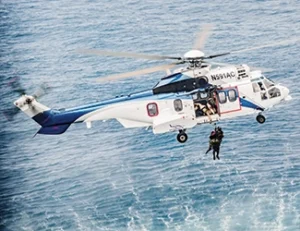
Airbus
One of the most recognized and proven offshore aircraft is the Airbus H225 Super Puma, which continues to serve today as a SAR helo in some of the harshest environments, including in severe icing conditions, like the North Sea. The H225 has a sophisticated avionics and autopilot system for demanding offshore rescue requirements.
Critical systems include power margin displays, an automatic collision avoidance system, auto level-off at low heights, vortex ring state protection, automatic transition to a hover, and fly away modes. All these features increase situational awareness and reduce pilot workload, which is critical when operating in high stress environments.
The Airbus family of highly capable SAR platforms also includes the H175, with a 600 nm range, up to 9700-ft hover outside of ground effect (HOGE), 150-kt cruise speed, and 5 hours of endurance. The state-of-the-art avionics and autopilot systems bring maximum efficiency to the cockpit, with fully redundant avionics and automatic rig approaches.
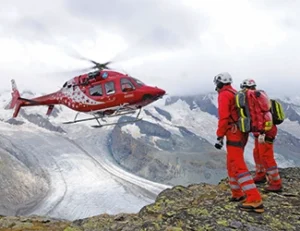
Bell 429
If the area of operations is not something as vast as the North Sea, but is still challenging, the Bell 429 is the helicopter of choice for Air Zermatt in the Swiss Alps.
The mountain environment demands an advanced aircraft with power and technology to advance the performance of SAR missions. Designed for passenger mobility and medical emergency services, the Bell 429 has the most cabin space in the light twin helicopter market, with flat flooring which is essential for medical care and litter placement. Combined with smooth flight characteristics and high reliability, the cabin can comfortably fit 2 litter carriers and multiple medical personnel.
In addition to ample cabin space, the Bell 429 excels at hot-and-high conditions with an impressive 11,290-ft HOGE and a 14,130-ft hover in ground effect (HIGE) – a must in the Swiss Alps. For ease of operation for cargo or litter loading, the wide aft clam shell doors provide safe and easy access in emergency situations.
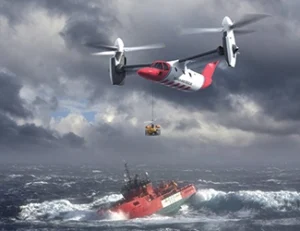
Leonardo
One of the most promising new aircraft to be certified soon is the civil tiltrotor, which combines the speed and range of a turboprop with the vertical lift characteristics of a helicopter.
The Leonardo AW609’s wide cabin door and 600 lb hoist capacity will easily handle a rescue basket. Once the patient is on board, medical care can be provided in the pressurized cabin while the aircraft transitions into airplane mode to cruise at speeds up to 270 kt.
The AW609’s advanced Collins Aerospace Fusion avionics are compatible with night vision goggles (NVGs), providing exceptional situational awareness and reducing pilot workload.
Leonardo helicopters excel in the SAR arena, with the AW139, AW169 and the AW189. Being a utility and cargo pilot at heart, this writer has always enjoyed more room in his helicopter. The AW189 is the largest in the series, and the 2 GE CT7-2E1 or Safran Aneto-1K turboshafts provide more than enough horsepower with a HOGE capability up to 9490 ft.
The cavernous interior allows for multiple stretchers and medical crews to provide excellent care once on board as the AW189 cruises at speeds up to 158 kt with a range up to 650 nm.
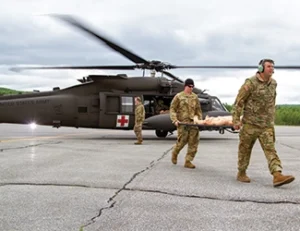
Sikorsky
Sikorsky helicopters have been saving lives for 6 decades up to the UH-60 Black Hawk or SK-70 and the S-92, soon to be in service for the President of the United States. The S-92 stands out because it is one of the few helicopters where the crew members can stand up.
The spacious cabin is 20 ft long, 6.6 ft wide, and 6 ft high, which allows medical and rescue personnel to move around the cabin freely. Due to its size, the cabin has multiple options with aux tanks, a cabin configuration with up to 6 litters, optional second hoist, both capable of lifting 600 lb, and a ramp for easy loading and unloading.
The performance numbers for the S-92 are as impressive as the S-92’s size. With standard fuel, the S-92 helicopter can rescue 2 survivors at 210 nm and 10 at 175 nm. With the optional auxiliary tanks installed, these distances expand out to 320 nm and 285 nm, respectively. The aircraft is FAA and JAA certified to fly in known icing conditions with optional protection for the main rotor and tail rotor. HOGE is 6700 ft and HIGE is 9200 ft, and maximum continuous cruise is 151 kt.
Mission equipment includes 4 fully integrated multi-functional screens with an optional 5th station in the back for mission information and functionality. As expected, the array of safety features includes multiple redundant systems, a suction fuel system to reduce the chances of a post-crash fire, and the fuel cells themselves are in sponsons outside the cabin to separate the fuel from the occupants.
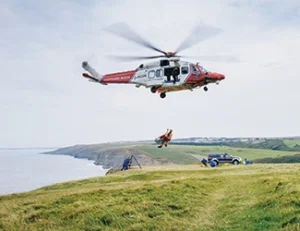
SAR associations and training
The best equipment in the world is useless if the people operating it has not received the proper training. Two organizations formed for the advancement of SAR operations are National Association for Search and Rescue (NASAR) and Priority 1 Air Rescue (P1AR).
NASAR is located in Williamsburg VA. Its mission statement is “Saving a life or returning a loved one’s remains are the noblest acts on earth. We know you are willing, let us help make you capable.” NASAR provides training around the country and prepares people for helping others. SAR can be a dangerous environment to work in, and participants must be properly trained or they will endanger themselves – and most likely endanger others.
P1AR provides a full spectrum of comprehensive ab-initio training to advanced level SAR, air ambulance/helicopter emergency medical services (HEMS), and tactical mission training programs. All training programs are standardized and interoperable with other P1AR training catalog courses to offer the customers the ability to provide succession into additional missions and aircraft types as their programs evolve.
Having rescued 8 survivors myself from the high-water freezing Susquehanna River after a record snow melt, I can say from experience that hoisting loved ones to safety or landing on roof tops to prevent their drowning is the most rewarding experience a pilot can live. The mission was flown in a single-engine Bell UH-1 Iroquois with rudimentary avionics and a hoist. Thankfully, we have come a long way in training and equipment development. Flightcrews are better equipped and trained so when the call comes in, men and women can respond with confidence and pride.